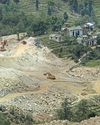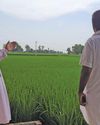
IN 2018, Swarm Technologies, a US startup, launched four small satellites into space on an Indian rocket that carried 31 payloads. The start up had been denied a licence by the US government because the satellites were too small to be tracked in space. The firm put its satellites on the launch anyway.
In February 2019, Israeli private company SpaceIL and space agency Israel Aerospace Industries launched Beresheet-the country's first lunar mission and the first attempt by a private firm to land on the moon. The spacecraft crashed on the moon in 2019.
Four months later, it emerged that Arch Mission Foundation, a US non-profit, had secretly sent a payload of microscopic eight-legged animals called tardigrades on Beresheet. Tardigrades are the sturdiest organism on Earth. Though experts say that these organisms cannot reproduce or establish a colony in the absence of liquid water and oxygen, their presence on lunar soil has raised ethical questions.
The incidents show not just the private sector’s increasing involvement in space exploration, but also its willingness to circumvent, even break, the basic governing principles.
One of the most important principles is safeguarding the solar system from contamination by Earth life, and Earth from possible extraterrestrial life forms, as enshrined in Article IX of the Outer Space Treaty (ost), a legally binding agreement in force since 1967. A total of 116 nations have ratified ost and are now responsible for ensuring that private organisations within their territories adhere to the principles of planetary protection. Planetary protection is also important to track the microbial population on a spacecraft because microbes might mutate due to evolutionary pressure exerted by space conditions. This can increase their pathogenic potential, which has repercussions on astronauts' health (see 'Space profoundly alters microbes' on p18).
This story is from the July 01, 2024 edition of Down To Earth.
Start your 7-day Magzter GOLD free trial to access thousands of curated premium stories, and 9,000+ magazines and newspapers.
Already a subscriber ? Sign In
This story is from the July 01, 2024 edition of Down To Earth.
Start your 7-day Magzter GOLD free trial to access thousands of curated premium stories, and 9,000+ magazines and newspapers.
Already a subscriber? Sign In

A SPRIG TO CARE FOR
Punarnava, a perennial herb, is easy to grow and has huge health benefits

DIGGING A DISASTER
Soapstone mining near Dabti Vijaypur village has caused many residents to migrate.

REVIEW THE TREATMENT
Several faecal sludge treatment plants in Uttar Pradesh suffer from design flaws that make the treatment process both expensive and inefficient

MAKE STEEL SUSTAINABLE
As India works to double its GDP by 2030, its steel industry must balance growth with sustainability. By embracing policies like the Steel Scrap Recycling Policy 2019 and adopting green technologies, India is paving the way for a more sustainable future in steel production

Can ANRF pull off the impossible for India?
Anusandhan National Research Foundation is expected to reorient India's innovation goals but funding issues, old mindsets remain a drag

TROUBLED WOODS
Forests are a great bulwark against climate change. But this is fast changing. AKSHIT SANGOMLA travels through some of the pristine patches of the Western Ghats to explore how natural disturbances triggered by global warming now threaten the forest health

BLINDING GLOW
The science is clear: increased illumination has damaging consequences for the health of humans, animals and plants. It’s time governments introduced policies to protect the natural darkness and improved the quality of outdoor lighting.

GROUND REALITY
What happens when the soil loses the ability to grow healthy, high-yield crops on its own?

GM POLICY MUST BE FARMER CENTRIC
On July 23, the Supreme Court of India directed the Union government to develop a national policy on genetically modified (GM) crops for research, cultivation, trade and commerce through public consultation.

Vinchurni's Gandhi
A 96-year-old farmer transforms barren land into a thriving forest in drought-prone region of Satara